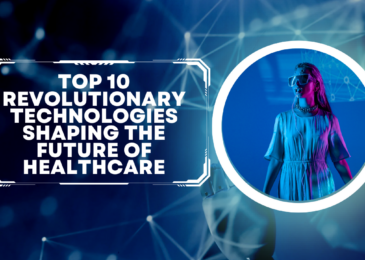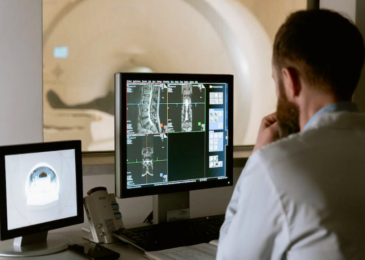The rapid advancements in medical devices and health technology are revolutionizing the healthcare landscape, promising unprecedented improvements in patient care and outcomes. Cutting-edge innovations such as wearable health monitors, AI-powered diagnostic tools, and minimally invasive surgical instruments are enhancing precision, efficiency, and accessibility. These breakthroughs are not only transforming disease management and treatment but also empowering individuals with real-time health insights, fostering a proactive approach to wellness. As the synergy between technology and medicine continues to grow, the potential for groundbreaking improvements in global health and quality of life becomes ever more profound.
Top 10 Breakthroughs in Medical Devices and Health Tech are:
1. Wearable Health Monitors
Wearable health monitors have revolutionized personal healthcare by providing real-time monitoring of vital signs and fitness metrics. Devices such as smartwatches and fitness trackers track heart rate, blood pressure, sleep patterns, physical activity, and even blood oxygen levels. These wearables enable individuals to gain insights into their health, empowering them to make informed lifestyle choices and proactively manage their well-being.
Advanced sensors and algorithms allow for the continuous collection and analysis of health data, facilitating early detection of abnormalities and potential health issues. This real-time data sharing with healthcare providers enhances patient care by enabling timely interventions and personalized treatment plans. Furthermore, the integration of wearable health monitors with smartphones and health apps has created comprehensive health ecosystems, promoting a holistic approach to wellness. As these devices continue to evolve, their potential to improve healthcare outcomes and quality of life is immense, heralding a new era of proactive health management.
2. AI-Powered Diagnostic Tools
AI-powered diagnostic tools are transforming the medical field by leveraging artificial intelligence to analyze complex medical data with unprecedented accuracy and speed. These advanced tools utilize machine learning algorithms to process and interpret medical images, pathology slides, genetic information, and patient records. By identifying patterns and anomalies that might be missed by human eyes, AI diagnostics can detect diseases like cancer, cardiovascular conditions, and neurological disorders at early stages, significantly improving patient outcomes.
The integration of AI in diagnostics enhances the precision of medical assessments, reduces diagnostic errors, and accelerates decision-making processes. For instance, AI algorithms can quickly analyze radiology images to pinpoint tumors, assess their growth, and suggest optimal treatment plans. Additionally, AI tools can continuously learn and improve from new data, ensuring up-to-date diagnostic capabilities.
3. Telemedicine Platforms
Telemedicine platforms have revolutionized healthcare delivery, offering patients the ability to consult with healthcare professionals remotely. Utilizing video conferencing, mobile apps, and secure messaging systems, these platforms facilitate real-time communication between patients and providers, making healthcare more accessible and convenient. Especially beneficial during the COVID-19 pandemic, telemedicine has ensured the continuity of care while minimizing the risk of infection.
Telemedicine platforms provide immediate access to medical expertise, reducing the need for travel and wait times for appointments. They are particularly advantageous for individuals in remote or underserved areas, who might otherwise face significant barriers to accessing healthcare. Additionally, telemedicine supports chronic disease management by enabling regular monitoring and follow-ups, improving patient outcomes through consistent care.
4. Robotic Surgery Systems
Robotic surgery systems represent a paradigm shift in surgical precision and innovation. These advanced systems, exemplified by the da Vinci Surgical System, combine cutting-edge robotics, high-definition imaging, and intuitive interfaces to empower surgeons with unparalleled control and dexterity during procedures. By translating a surgeon’s hand movements into precise, minimally invasive actions inside the body, robotic surgery systems enable enhanced precision, flexibility, and access to anatomical structures.
The benefits of robotic surgery are manifold. They include smaller incisions, reduced blood loss, faster recovery times, and fewer post-operative complications compared to traditional open surgery. Additionally, the high-definition imaging capabilities provide surgeons with detailed, magnified views of the surgical site, allowing for more precise tissue manipulation and better outcomes.
5. 3D Printing of Medical Devices
The advent of 3D printing technology has revolutionized the manufacturing of medical devices, offering unprecedented levels of customization, precision, and innovation. From implants and prosthetics to surgical instruments and anatomical models, 3D printing enables the creation of complex medical devices with intricate designs tailored to individual patient needs.
One of the most significant advantages of 3D printing in healthcare is its ability to produce patient-specific implants and prosthetics. By using patient imaging data, such as CT scans or MRI scans, healthcare providers can design and fabricate implants that perfectly match the patient’s anatomy, leading to better fit, function, and comfort. Moreover, 3D printing allows for rapid prototyping and iteration, accelerating the development of new medical devices and reducing time-to-market.
6. Smart Implants
Smart implants represent a revolutionary advancement in medical technology, integrating sensors, wireless connectivity, and data processing capabilities into implantable devices. These sophisticated devices monitor physiological parameters, deliver targeted therapies, and provide real-time feedback on patient health.
One notable application of smart implants is in the field of remote patient monitoring. Implants equipped with sensors can continuously monitor parameters such as glucose levels in diabetic patients or pressure in cardiac patients, transmitting data to healthcare providers for remote assessment and intervention.
7. Digital Therapeutics
Digital therapeutics (DTx) are a groundbreaking form of healthcare intervention that utilize software-based solutions to manage, treat, and prevent various medical conditions. Unlike traditional pharmaceuticals, DTx programs deliver evidence-based therapeutic interventions through mobile apps, online platforms, and wearable devices.
These interventions can target a wide range of conditions, including chronic diseases like diabetes, cardiovascular conditions, mental health disorders, and substance abuse. DTx programs typically incorporate elements of cognitive behavioral therapy, mindfulness training, medication adherence support, and personalized coaching to empower patients to take control of their health.
One of the key advantages of digital therapeutics is their scalability and accessibility, allowing patients to access high-quality care anytime, anywhere.
8. Point-of-Care Diagnostic Devices
Point-of-care diagnostic devices have emerged as indispensable tools in modern healthcare. It is offering rapid and accurate testing at the patient’s bedside or in remote settings. These portable devices enable healthcare providers to obtain timely diagnostic information. Facilitating quick decision-making and appropriate treatment interventions.
Examples of point-of-care diagnostic devices include handheld ultrasound machines, portable blood analyzers, rapid antigen tests, and glucose monitors. These devices are designed to deliver results within minutes. Eliminating the need for samples to be sent to centralized laboratories and reducing turnaround times.
Point-of-care diagnostics are particularly valuable in emergency situations, rural healthcare settings, and resource-limited environments where access to traditional laboratory facilities is limited.
9. Gene Editing Technologies
Gene editing technologies, particularly CRISPR-Cas9, have revolutionized the field of medicine by offering precise and efficient tools for modifying genetic material. These technologies enable scientists to make targeted changes to DNA sequences. Allowing for the correction of disease-causing mutations, the introduction of therapeutic genes, and the study of gene function.
One of the most promising applications of gene editing is in the treatment of genetic disorders. CRISPR-Cas9 can potentially correct mutations responsible for conditions. Like cystic fibrosis, sickle cell anemia, and muscular dystrophy, offering hope for effective treatments and cures.
Moreover, gene editing technologies are being explored for applications beyond genetic diseases. Including cancer therapy, infectious disease prevention, and agricultural biotechnology.
10. Augmented Reality (AR) and Virtual Reality (VR) in Medicine
Augmented Reality (AR) and Virtual Reality (VR) technologies are reshaping the landscape of medical education, training, and patient care. In medical education, AR and VR simulations offer immersive learning experiences. Allowing students to visualize complex anatomical structures, practice surgical procedures, and simulate medical scenarios in a risk-free environment.
In surgical planning and navigation, AR overlays provide surgeons with real-time, three-dimensional anatomical information during procedures, enhancing precision and reducing the risk of errors. VR simulations are also utilized for preoperative planning and rehearsal. Enabling surgeons to familiarize themselves with patient-specific anatomy and anticipate potential challenges.
Furthermore, AR and VR are being integrated into patient care for pain management, rehabilitation, and patient education. VR environments can distract patients during painful procedures, while AR overlays can provide visual cues and instructions for rehabilitation exercises.
Conclusion
In conclusion, the remarkable breakthroughs in medical devices and health technology are revolutionizing healthcare delivery and patient outcomes. From wearable health monitors providing real-time data insights to AI-powered diagnostic tools enabling early disease detection. These innovations are enhancing precision, accessibility, and efficiency in healthcare. Robotic surgery systems are transforming surgical procedures, while 3D printing of medical devices allows for personalized solutions. Smart implants, digital therapeutics, and point-of-care diagnostic devices are optimizing patient care and treatment approaches. With the integration of gene editing technologies and augmented reality in medicine. The future promises even greater advancements, ultimately improving global health and well-being.
Read more:







